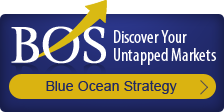
Blue Ocean Strategy Review
Reviewed by Dr. Sarah Layton
Dr. Sarah Layton (mailto:info@corporatestrategy.com; http://www.corporatestrategy.com/) is Managing Partner of Corporate Strategy Institute, Orlando, Florida. She is qualified by the Blue Ocean Strategy Initiative Center – London, in Blue Ocean Strategy concepts, tools and frameworks and specializes in helping organizations create their Blue Ocean Strategy future.
Summary
If you ever hear your executives whine about the competition, you will want to read this book. It is about how a company can do things so differently that it moves into an entirely different marketplace, even a different industry. The authors have been called “two of Europe’s brightest business thinkers,” have written for all the major business publications, and are distinguished professors at INSEAD.
In Blue Ocean Strategy, they describe the red ocean as where most companies compete, seeking customers from the same market as their competitors, Kim and Mauborgne suggest that companies break out of the red ocean of bloody competition by creating uncontested market space in the blue ocean that makes the competition irrelevant. Red Ocean Strategy focuses on existing customers, and has the following traits:
RED OCEAN STRATEGY
-
Focus on existing customers
-
Compete in existing market space
-
Beat the competition
-
Exploit existing demand
-
Make the Value-Cost trade-off
- Align the whole system of a firm’s activities with the strategic choice of differentiation or low cost
In contrast, blue ocean strategy has the following attributes:
BLUE OCEAN STRATEGY
-
Focus on non-customers
-
Create uncontested market space
-
Make the competition irrelevant
-
Create and capture new demand
-
Break the value-cost trade-off
- Align the whole system of a firm’s activities in pursuit of differentiation and low cost
Successful blue ocean companies include Callaway Golf, NetJets, and Cirque de
Soleil. But companies have been creating blue ocean strategies for decades. Callaway went after nongolfers intimidated by the sport, gave them a club head so huge they couldn’t miss the ball, and won over duffers in the process. NetJets took the speed and flexibility of the corporate jet and the lower cost of commercial travel and offered the best of both industries in fractional “timeshare” jet ownership. Cirque de Soleil redefined the circus by eliminating the animals, the travel, and the three rings, thereby appealing to an upscale market looking for entertainment.
Guiding Principles
As you create your blue ocean strategies, be aware of four guiding principles. The first is to break from the competition and reconstruct market boundaries. For example: Novo Nordisk looked past the red ocean of doctors as the market for insulin to the blue ocean of diabetics and became a diabetic’s care company rather than just a producer of insulin.
The second guiding principle is to focus on the big picture, not the numbers. As a strategist, I have long tried to convince clients that when the strategy is right and implemented, the numbers will happen. The right strategic planning process is critical to developing a good strategy. Unfortunately, old habits die hard, and planning processes become mired in the numbers.
The third guiding principle is to reach beyond existing demand. Historic strategic planning processes encourage focusing on current markets and further defining niches, thus continuing a red ocean existence.
To have a profitable and robust strategy, you must follow the fourth guiding principle: get the strategic sequence right. The right strategic sequence of buyer utility, price, cost, and adoptions will ensure commercial viability.
Business models usually start with the cost and build the price based on how much profit they want to make. Blue ocean strategies suggest starting with the utility to the customer and then setting the consumer price and designing the model so that the cost allows the profit desired. My experience is that companies juggle cost and price, trying to decide the highest price the market will bear and adding or subtracting features until they get a nominal product they think they can sell at the highest profit. Many times they never even get around to the subject of value to the customer.
How to create Blue Oceans
Value innovation is the cornerstone of blue ocean strategy and is not new. Porter and others have espoused innovation for decades. What is new is how Kim and Mauborgne suggest that innovation align with utility, price, and cost positions while overcoming the execution hurdles. They decry the value cost tradeoff so common today and provide useful tools that encourage you to think alternatives instead of competitors, and noncustomers instead of customers.
One tool is the strategy canvas used to create value. This is a diagnostic and action-oriented chart that plots the current state of play (low vs. high activity) in the known market against the range of factors used to compete. The resulting value curve shows where the competition is currently investing and what they offer buyers. This creates the current value curve. Once you have created that, look at each factor and decide which of four primary actions (eliminating, reducing, increasing, or creating) could be taken to create value to noncustomers. These actions will dramatically change your value curve.
For example: What factors on the strategy canvas should be eliminated that don’t add value? Casella Wines eliminated the aging and tannin qualities, two factors that intimidated customers.
What factors should be reduced below the industry standard to avoid over delivering? Casella Wines limited their offerings to just one white wine and one red wine (Yellow Tail) to avoid customer confusion.
What factors should be raised above the industry standard so that customers won’t have to make compromises? Casella Wines raised the involvement of Yellow Tail retailers by providing them with Australian outback clothing, which helped make the wine seem friendly instead of intimidating.
What factors should be created that are new to the industry? Casella wines created new customer experiences for wine drinking; easy drinking, ease of selection, and a sense of fun and adventure.
Characteristics of Blue Ocean Strategy
Once these actions have been taken, look to see if your strategy has the three characteristics of a good blue ocean strategy. Does it have focus? Does it diverge from other players? Does it have a good tag line? Look to alternatives rather than the competition.
For example: SouthWest Airlines chose to look at automobile transportation, not other airlines, as the alternative for comparison. By focusing on friendly service, speed, and frequent point-to-point departures, they were able to price against car transportation. They diverged by eliminating, reducing, raising, and creating value that differentiated their profile from the average airline. Their tag line: “the speed of a plane at the price of a car—whenever you need it,” was very compelling, and sales took off.
Execution is Key
The final section of the book goes into detail about how to execute the blue ocean strategy. This is an important section that covers overcoming the organizational hurdles: how to build execution into the blue ocean strategy, and how to sustain and when to renew the strategy.
How do you get employees to be aware of the need for the new strategy, abandon the status quo, and jump on the execution wagon? How can you accomplish each phase without increasing the resources needed? How do you motivate employees to become enthusiastic supporters rather than reluctant participants or, worse, saboteurs? Tipping point leadership—popularized by Malcom Gladwell’s book, The Tipping Point—where leaders mobilize a company by flipping conventional wisdom on its head, is necessary to overcome these hurdles quickly at low cost, winning support for the strategy in the process.
Before people will execute a new strategic plan, their minds and hearts must align with the new strategy. Then they willingly go beyond compulsory execution to voluntary cooperation in implementation. Fair process is vital here. When management has engaged employees in pertinent aspects of the strategic decision making, explained the strategic choices, and effectively communicated the new rules of the game—then employees will judge the process as fair. A blue ocean strategy successfully implemented provides strong barriers of imitation, giving a 10- to 15-year lead over the competition.
Copyright © 2005 Dr. Sarah Layton; first serial rights to C2M – Consulting to Management. This review was published in slightly different format in the December, 2005 issue of C2M.
Contact Dr. Layton at info@CorporateStrategy.com




















No Comments Yet
You can be the first to comment!